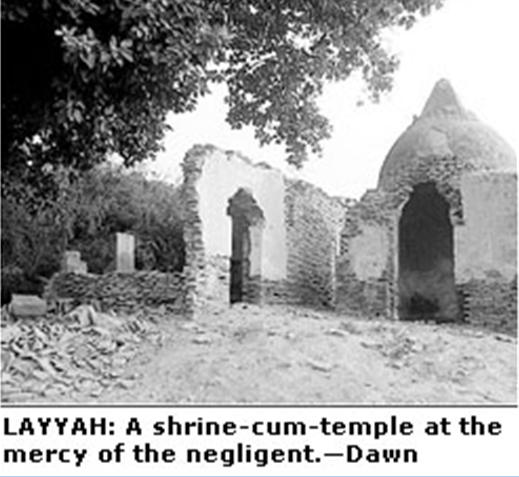Layyah
This is a collection of articles archived for the excellence of their content. Readers will be able to edit existing articles and post new articles directly |
Layyah
The flickering light of inspiration
By Fareedullah Chaudhry
LAYYAH, Nov 9: The 16th-century Mai Mattaa shrine-cum-temple is facing threat of obliteration due to alleged negligence of the Evacuee Trust Property Board officials. It remained a major source of inspiration for Muslim and Hindu devotees until August 1947.
It is one of nearly 60 shrines in the district and has been abandoned for the last few decades.
A local historian, Mehar Noor Muhammad Thind in his pioneer work Tareekh-i-Layyah records that Mai Mattaa was born in a Hindu family, but she used to recite ‘Raheem’ instead of Ram during her worship. Predominantly Hindu community of the 16th century got infuriated and tried to kill her, but she managed to get the blessings of Sufi saint Kamo Kamil and eventually embraced Islam.
To begin her new journey of spiritualism, he writes, the woman made an oak tree her abode where she with the blessings of her spiritual mentor Kamo Kamil started giving oil to Muslims and Hindus which served as a balm against skin diseases.
When chickenpox plagued the area, she started giving spiritually medicated oil which would rid the devotees of chickenpox — a disease that was then called Mattaa in local language. Henceforward, she began to be known as Mai Mattaa (the mother who heals chickenpox).
The revenue record of 1878 shows that the area where Mattaa shrine is located is called “Chah (well) Mattaa Walla” and owner of the property is Bawa Awododaas, a disciple of Bawa Kanwaldaas (Faqeer Bairagi).
Keeping in view the public affiliation with the shrine, the then government waived the taxes within (lagaan) of this Chah for good. A Hindu temple, Hindu graveyard (Marri) and a hostel for the pilgrims was also built along with the shrine which came to be known as Mai Mattaa temple.
The shrine-cum-temple remained intact until August 1947, says a local archaeologist, Hakim Elahi Bakhsh Serai. But during the last sixty years, he says, the persistent decay of this historical monument is more than evident thanks to the apathy of the archives department.
Says Hakim Serai: “History has been a major casualty of post-independence era and re-writing of a fictitious and imaginative history by religious ideologue has played havoc with our glorious and shining archeological assets on both sides of Indo-Pak and the Mai Mattaa’s temple is a painful example of that civilisation crime”.
Social circles and devotees have demanded that the Punjab governor should order immediate measures to save the shrine-cum-temple from extinction.
ETPB officials told this correspondent that they were not responsible for the maintenance of this particular temple as “it had been abandoned after partition”.
